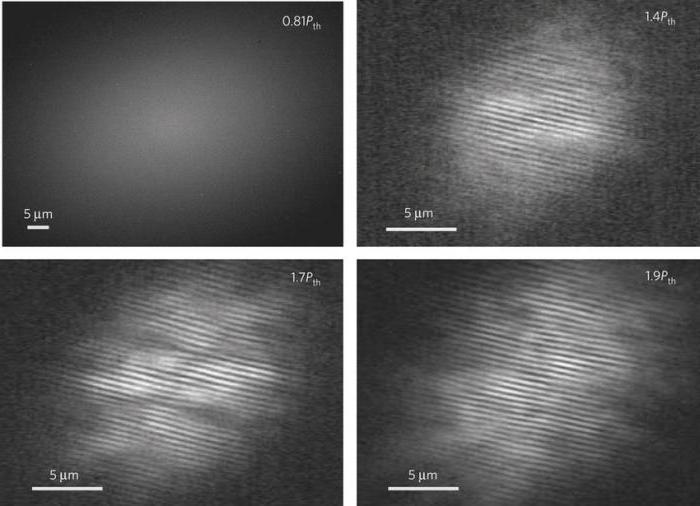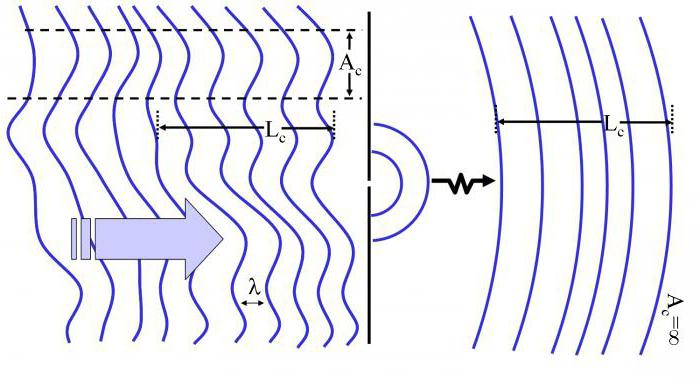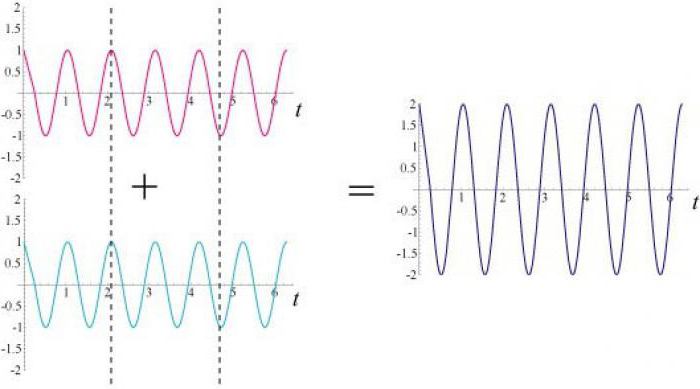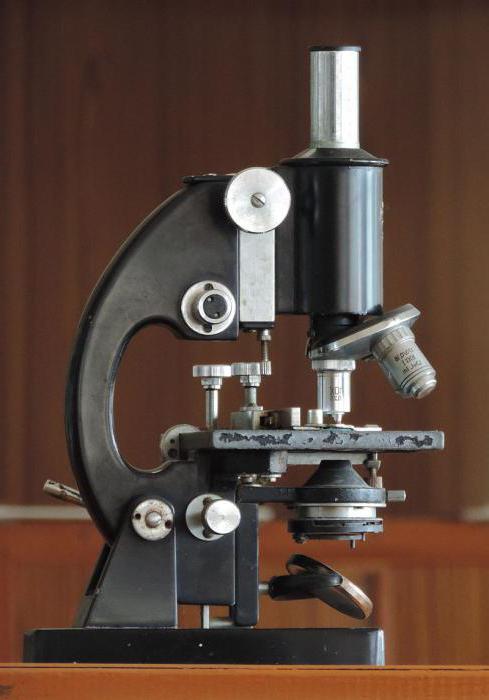Coherence is ... Coherence of light waves. Temporal coherence
Consider a wave propagating in space. Coherence is a measure of the correlation between its phases, measured at various points. The coherence of a wave depends on the characteristics of its source.
Two types of coherence
Let's look at a simple example. Imagine two floats rising and falling on the surface of the water. Suppose that the source of the waves is a single stick, which is harmoniously immersed and removed from the water, disrupting the smooth surface of the water surface. In this case, there is an ideal correlation between the movements of two floats. They may not rise and fall exactly in phase, when one goes up and the other down, but the phase difference between the positions of the two floats is constant in time. A harmonically oscillating point source produces an absolutely coherent wave.
When describing the coherence of light waves, there are two types of light waves - temporal and spatial.
Coherence refers to the ability of lightto produce an interference pattern. If two light waves are brought together, and they do not create areas of increased and reduced brightness, they are called incoherent. If they produce an "ideal" interference pattern (in the sense of the existence of regions of complete destructive interference), then they are completely coherent. If two waves create a "less perfect" picture, then they are considered to be partially coherent.

Michelson interferometer
Coherence is a phenomenon that is best explained by experiment.
In the Michelson interferometer, the light from the source S (which can be any: the sun, laser or stars) is directed at the semitransparent mirror M0, which reflects 50% of the light in the direction of the mirror M1 and passes 50% in the direction of the mirror M2. The ray is reflected from each of the mirrors, returns to M0, and equal parts of the light reflected from M1 them2, are combined and projected onto screen B. The device can be adjusted by changing the distance from the mirror M1 to the beamsplitter.
The Michelson interferometer, in essence, mixes the beam with the delayed time in its own version. The light that passes along the path to the mirror M1 must pass a distance of 2d more than the beam that moves to the mirror M2.

Coherence length and time
What is observed on the screen? For d = 0, we see a lot of very clear interference fringes. When d increases, the bands become less pronounced: the dark areas become brighter and the light areas become dimmer. Finally, for very large d exceeding some critical value of D, the light and dark rings disappear completely, leaving only a blurred spot.
It is obvious that the light field can notinterfere with the delayed version of itself, if the time delay is sufficiently large. Distance 2D is the coherence length: interference effects are noticeable only when the path difference is less than this distance. This value can be converted at time tc dividing it by the speed of light c: tc = 2D / s.
Michelson's experiment measures the temporal coherence of a light wave: its ability to interfere with a delayed version of itself. A well-stabilized laser tc= 10-4 c, lc= 30 km; for filtered thermal light tc= 10-8 c, lc= 3 m.

Coherence and time
Temporal coherence is a measure of the correlation between the phases of a light wave at various points along the direction of propagation.
Suppose a source emits waves of length λ and λ ± Δλ that at some point in space will interfere at a distance lc = λ2 / (2πΔλ). Here lc Is the coherence length.
The phase of the wave propagating in the x direction is given by φ = kx - ωt. If we consider the pattern of waves in space at time t at a distance lc, the phase difference between two waves with vectors k1 and k2, which are in phase at x = 0, is equal to Δφ = lc(k1 - k2). When Δφ = 1, or Δφ ~ 60 °, the light is no longer coherent. Interference and diffraction have a significant effect on contrast.
In this way:
- 1 = lc(k1 - k2) = lc(2π / λ - 2π / (λ + Δλ));
- lc(λ + Δλ - λ) / (λ (λ + Δλ)) ~ lcΔλ / λ2 = 1 / 2π;
- lc = λ2 / (2πΔλ).
The wave passes through the space at a speed c.
The coherence time tc = lc / from. Since λf = c, then Δf / f = Δω / ω = Δλ / λ. We can write
- lc = λ2 / (2πΔλ) = λf / (2πΔf) = c / Δω;
- tc = 1 / Δω.
If the wavelength or propagation frequency of a light source is known, lc and tc. It is not possible to observe an interference pattern obtained by dividing an amplitude, such as thin-film interference, if the optical path difference is significantly greater than lc.
The temporal coherence indicates the monochrome nature of the source.

Coherence and space
Spatial coherence is a measure of the correlation between the phases of a light wave at various points transversely with respect to the direction of propagation.
At a distance L from a thermal monochromatic (linear) source whose linear dimensions are of the order of δ, two slits located at a distance greater than dc = 0.16λL / δ, no longer produce a recognizable interference pattern. πdc2 / 4 is the source coherence area.
If at a time t look at the sourcewidth δ located perpendicular to the distance L from the screen, then on the screen you can see two points (P1 and P2) separated by a distance d. The electric field in P1 and P2 is a superposition of the electric fields of the waves emitted by all points of the source, the radiation of which is not related to each other. In order for the electromagnetic waves leaving P1 and P2 to create a recognizable interference pattern, the superpositions in P1 and P2 must be in phase.

The coherence condition
Light waves emitted by two edgessource, at some instant t have a certain phase difference right at the center between two points. A ray from the left edge of δ to the point P2 must pass d (sinθ) / 2 further than the ray directed to the center. The trajectory of the ray going from the right edge δ to the point P2 passes the path to d (sinθ) / 2 less. The path difference for the two rays is d · sinθ and represents the phase difference Δφ "= 2πd · sinθ / λ .For the distance from P1 to P2 along the wave front, we obtain Δφ = 2Δφ" = 4πd · sinθ / λ. The waves emitted by the two edges of the source are in phase with P1 at time t and do not coincide in phase at a distance of 4πdsinθ / λ in P2. Since sinθ ~ δ / (2L), then Δφ = 2πdδ / (Lλ). When Δφ = 1 or Δφ ~ 60 °, the light is no longer considered coherent.
Δφ = 1 -> d = Lλ / (2πδ) = 0.16 Lλ / δ.
Spatial coherence indicates the homogeneity of the phase of the wave front.
The incandescent lamp is an example of an incoherent light source.
Coherent light can be obtained from a sourceincoherent radiation, if one rejects most of the radiation. First of all, spatial filtration is performed to increase spatial coherence, and then spectral filtration to increase temporal coherence.

Fourier series
The sinusoidal plane wave is absolutely coherentin space and time, and its length, time and area of coherence are infinite. All real waves are wave impulses that last for a finite time interval and have a finite perpendicular to their propagation direction. Mathematically, they are described by nonperiodic functions. To find the frequencies present in the wave pulses for determining Δω and the coherence length, it is necessary to analyze the nonperiodic functions.
According to Fourier analysis, an arbitraryThe periodic wave can be regarded as a superposition of sinusoidal waves. The Fourier synthesis means that the superposition of a set of sinusoidal waves makes it possible to obtain an arbitrary periodic waveform.

Communication with statistics
The theory of coherence can be regarded asthe connection of physics with other sciences, since it is the result of the fusion of electromagnetic theory and statistics, as well as statistical mechanics is the union of mechanics with statistics. The theory is used to quantify and characterize the effects of random fluctuations on the behavior of light fields.
It is usually impossible to measure fluctuations in the wavefields directly. Individual "ups and downs" of visible light can not be detected directly or even with complex instruments: its frequency is of the order of 1015 fluctuations per second. Only average values can be measured.
Application of coherence
The connection of physics with other sciences by examplecoherence can be traced in a number of applications. Partially coherent fields are less susceptible to atmospheric turbulence, which makes them useful for laser communications. They are also used in the study of laser-induced reactions of thermonuclear fusion: a decrease in the interference effect leads to a "smooth" action of the beam on the thermonuclear target. Coherence is used, in particular, to determine the size of stars and the separation of binary stellar systems.
The coherence of light waves plays an important role inthe study of quantum, as well as classical fields. In 2005, Roy Glauber became one of the Nobel Prize laureates in physics for his contribution to the development of the quantum theory of optical coherence.
</ p>

